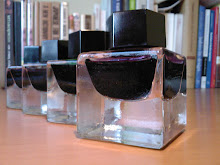I received news today that my teacher, Aino Paasonen passed away on July 14, 2010. This is in remembrance of her teaching and contributions to my own learning and life.
* * * *
Sometime during early Fall of 1997 as a second year student at SCI-Arc, I met Aino.
She was amazingly tall, I remember, and spoke with a commanding yet gentle voice. Aino was going to teach all of us in second year writing, and to expose us to thinking in the humanities, she announced.
I did not quite understand then why all of us had to learn writing—all of us could write, of course, or so I thought—or the humanities. After all, isn’t this a school of architecture? I remember resisting Aino’s call with my sketchbook and pen in hand, determined to carry on with my little ‘design’ doodles in her class—in secret and at the back of the large classroom if I had to.
As the warmth of early Fall in Los Angeles trickled away, I soon realized that Aino’s class started at an ungodly cold hour in the morning when no student—habitually after long nights of working—ought to be awake reading long epics of Gilgamesh or Homer. And so I found myself stealing sleep, along with many of my classmates I am sure, in Aino’s class. One of my classmates, whom I shall not name here, labeled Aino’s class, a ‘napping session’—a foolish notion that then, I also concurred foolishly.
Amid her explication of the classics, I was quite certain that Aino was cunningly aware of those of us who were masquerading our design doodling with note-taking, and those of us who were simply snoring away. Despite these clandestine activities going on right under her nose, she had simply refused the easy way out by calling us up. Naively, I had only taken her humanistic sensitivity to our plight as design students for a form of tutorial indifference.
Nonetheless, I remember a few instances when Aino was not too pleased to discover that none of us read what she had assigned. But Aino never left the class in a characteristic angry huff practiced by many teachers; instead, she persevered and improvised her teaching despite our collective betrayal. I do not know if it was my growing guilt or fear or respect—for Aino inspired all—but her class caught on for me amid my secretive doodling and growingly also, unwilling napping.
I remember one episode in Aino’s class vividly: Aino’s recitation of Dante’s Divine Comedy in Italian. I can still hear her voice in my head: ‘listen to this in Italian’. I did not understand a single word she said, nor could I have known then that this was the last I listened to Aino’s recitation of the Divine Comedy. Even so, I remember that her voice was uplifting, and her spirit joyous. It was as if Dante’s words were honey and she was relishing every drop of it. Then, I must have encountered something akin to the intellect richly mixed with poetic love.
* * * *
I could not have realized then the privilege of being taught by Aino, a humanist who understood the need to educate humanistic designers, especially so today amid the great distress and suffering primarily caused by man-made problems.
Although Aino has left the nettles of this world, her legacy for humanism remains. On this, something of the late Aino Paasonen—her humanistic conviction, and her intellectual love—will always stay with me: in memory at Beethoven Street, and in practical actions for today and the future.
Thank you Aino, for your teaching in my own learning and life, and for your contributions to SCI-Arc. Drink with the gods and rest well.
